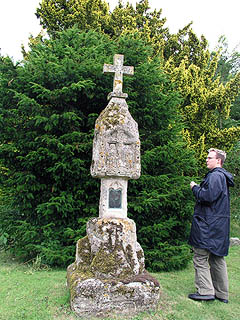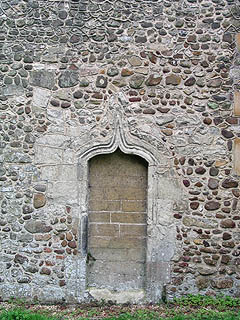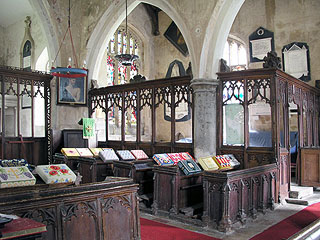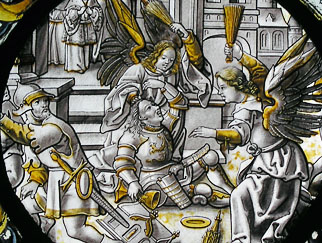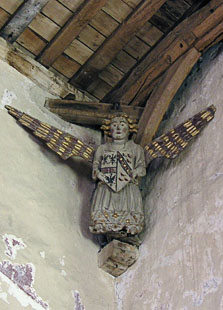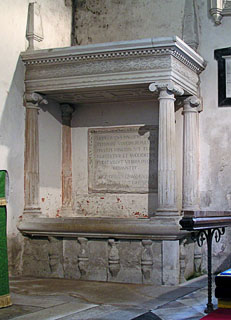Here on the western edge of Cambridgeshire, surrounded on three sides by Huntingdonshire, is one of the most beautiful church locations I’ve come across. St James sits in splendid isolation, surrounded by Croxton Park – it was a delight to sweep along the estate road past the oak trees and the verdant grass.
Such delightful tranquillity has a cost, of course, and it wasn’t hard to realise that under the grass near St James must lie the site of the old village of Croxton. As happened all too often, the local gentry (the Leeds family here) decided that they wanted a better vista from their drawing rooms, and so most of the village was destroyed as a result. The remnants now line the street between the park and the main road – a sad fragment, but there are some gorgeous cottages. I think Manor House – the southernmost house on the western side of the road – is probably my favourite house in all of Cambridgeshire, a wonderful densely timbered hall with cross-wings, surrounded by an exuberant garden.
St James doesn’t really compete with such beauty – it’s a muddled, higgledy-piggledy building, more intriguing than exciting. Still, we found enough to keep us occupied for quite a while (and I’m not just referring to having to telephone the churchwardens to try and get hold of a key…). Take, for example, the old-looking cross in the churchyard. It is now a monument commemorating the vicar since the Reformation, but the core is a medieval preaching cross, I think: a very gnarled octagonal base, and a head with four niches containing carvings. The carving has suffered from the elements, and is now cloaked in delicate frilly lichen, but the images can just be made out. One shows the Crucifixion, and the others depict St Michael weighing souls, a bishop squashing a dragon and St Anthony with his pig.
The body of the church itself is mostly 13th century, though it’s been much restored. The tower is a solid 15th century rebuild in honey-coloured stone (though the corners are built of greyish stone, presumably because it was harder). The tower isn’t very high, but has a cheerful, rich look to it: there’s a big clock set into the north face, and lots of good gargoyles, as well as a string course about 10 feet from the ground decorated with flowers and monograms.
The rest of the exterior bears the scars of even later building. There’s a door in the north wall of the chancel with a dramatic spike-shaped ogee that dates from the early 17th century.
Most of the south aisle was rebuilt in 1904, and the north porch three years later as a memorial to one Robert Alexander Cochrane by his two daughters Constance and Florence. The porch replaces a two-storey structure with a parvise, but I gritted my teeth and managed to squeeze out some enthusiasm about the replacement. The side walls are an interesting jumble of masonry – bits of reused pillars and piscinae – and there are several dates (1739 and 1779, to take two) preserved in the amber of the 20th century mortar.
Over the door is a little bracket and niche for a statue, and the door itself is quite interesting – it has a tympanum with a scalloped frame containing a little 16th century Flemish carving of the Virgin and child sitting in the manger – a rude roof over the top and a couple of beasts behind her.
The first impression on entering is of a mass of interesting woodwork. There are old benches in the nave, and (rarity of rarities!) both aisles have parclose screens. These have been modified, altered and aregenerally a bit battered, but they survive and I quite liked the later additions: there are classical scrolls and swirls on the tops of the beams, and on the north side one of the verticals has been truncated to allow a wide gate through into the chapel. The medieval work is very plain, but it’s still nice to see such things surviving. There’s also a chancel screen, though that is Victorian: full marks for putting one back, but why not make it match the others?
In the north chapel, we had rather a surprise. The main window depicts the story of the Good Samaritan, and is almost exactly identical to one we’d seen a little while earlier at Cottenham. It’s a fine window – nice robust artistry and much more to my taste than wispy Merchant Ivory angels – but for some reason I was disappointed to discover that it was mass-produced. Elsewhere, there are lots of bits and bobs of medieval glass, but mostly just tiny fragments: angels’ heads, monograms and so on. [Mark adds: one of the windows has a (probably) 17th century roundel depicting angels beating to death someone who has been despoiling a temple - would that the burly angels in the roof here had done as much to Dowsing and his thugs when they were here on March 8 1643: 'Croxton. John Suton, Cunstable, John Lyne, church-warden. A crucifix we brake, and the rayles, and brake 20 superstitious pictures; one crucifix, and 2 crosses to be taken downe, one in the steeple, and another in the highway. Upon the bell Sit Munus Domini']
Over the chancel arch are some faint traces of painting – possibly an image of John the Baptist. Apparently there’s more under the plaster there, and the parish is waiting until it has the money to investigate (and conserve) it properly. That’s entirely proper, of course, but rather frustrating! Still, I’ve seen enough dirty walls where the Victorians uncovered paintings and left them to fade or crumble away that I recognise the wisdom of their decision: it would be a pity to lose such things due to lack of ability to maintain them.
Having gone to the dreadful bother of looking upwards I was rewarded with a vision of angels. Great big angels, with huge red and gold striped wings, and golden hair. There are four of them, at each corner of the nave, and their size is accentuated by how low down they are (the lack of a clerestory means that the roof rises from hardly higher than the nave arcades). The guidebook, much to my surprise, suggests that angels and roof were put in together in 1659.
This would explain why they weren’t destroyed in the various waves of iconoclasm that normally did for such things: if angels survive, it is often because they were too high to be reached easily. And we know that Cromwell’s soldiers were billeted here, so such low angels, if they had been medieval and survived the Edwardian and Elizabethan purges, would surely have fallen prey to blunderbuss and pike. Even so, the thought of new angels being put on a roof in 1659 – during the Puritan Commonwealth! – is just as implausible to my mind: certainly I’ve never come across anything of the sort ever before.
Moving through into the chancel, it’s best to ignore the east window. The artist has managed the seemingly impossible task of making St John look like a fat version of Maggie Smith, gazing blandly up at Jesus on the cross. Instead, one can explore the fine monuments. There are the usual wall plates, of course: one that particularly caught my eye was that of one Edward Leeds and his wife Martha. Martha died in 1670 and Edward in 1679, aged 70 and 93 respectively: they were married for 52 years, which struck me as very impressive.
Even better, though, is the tomb in the south-east corner of the chancel, up next to the altar. This commemorates another Edward Leeds, Master of Clare Hall from 1560 to 1571 and was a founding benefactor of Emmanuel. He died in 1589, and it was he that acquired the manor of Croxton after he left the groves of academe in 1571. His tomb is very severe and Roman-looking: four ionic columns support a solid architrave, complete with strapwork decoration. On top there used to be four obelisks, though only one and a half of them remain, and beneath the canopy is a chest with a brass of Edward himself dressed in fine robes.
On the back wall is a plaque with the Latin scripture that normally gets translated as ‘Man that is born of woman hath but a short time to live…’ As we drove away, I thought of that, and of the lost village beneath the earth, and for a moment felt sober and mournful: and then the sheep, and the oak trees, and the green grass, and I forgot to be serious.
We found St James locked without keyholder information,
but the
churchwardens were able to tell us where to find a key when we telephoned
them

